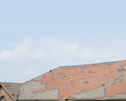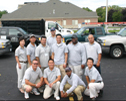In 1988, Father Gene Kutsch of St. Anthony Parish, Dubuque, Iowa, established a sister relationship between St. Anthony and St. Monfort, Port-de-Paix, Haiti, as part of the Haiti Parish Twinning Program. The two parishes have had an ongoing relationship ever since, with St. Anthony parishioners and pastors providing materials, food, medical assistance and spiritual support to the St. Monfort parish and school.
With St. Anthony's help, St. Monfort has provided great assistance to the poor community it has been serving for about 75 years. In addition to donating food and clothing, the church has provided shelter during many heavy tropical storms, which have caused the church to lose much of its roof structure. With no money to fix the roof and other damaged areas, the structurally unsafe building sat in disrepair as water poured into the building during storms.
In early 2009, Jim Giese, owner of Jim Giese Commercial Roofing Inc., Dubuque, learned about the damage to St. Monfort through an acquaintance involved with St. Anthony parish.
"He mentioned St. Monfort had a roofing problem and asked whether I would look at some photos of the damage," Giese says. "When I looked, I said: 'They have a lot more than a roofing problem.' I told him what I thought the building needed and made a list of the trades that would be required—but St. Anthony didn't know where to go with it, so they came back to me."
Giese contacted Bob Hartig, an architect who is a member of St. Anthony parish. Hartig agreed to design a repair plan for St. Monfort if the building was salvageable. To evaluate the building's condition, Giese would need to travel to Port-de-Paix and inspect the damaged building and roof system.
Figuring it out
In March 2009, Giese, along with Jeff Tharp, a journeyman sheet metal worker with Dubuque-based Giese Sheet Metal Co. (owned by Giese's brother and cousin), and Mel Harvey, a member of St. Anthony, traveled to Port-de-Paix to gather architectural and structural information about the damaged building to determine whether it could be saved.
"The roof was in extremely poor condition," Giese says. "It would bend when you walked on it, and there was a ton of water coming in. The backs of the parapet walls were coming off; the ribs of the dome were rusted out; and water was leaking down the walls into the body of the church."
In addition to the extreme deterioration of the masonry parapets; considerable rotting and damage to some portions of the wood structure supporting the roof and dome; and severe rusting of portions of the metal roof on the dome and church, the windows and siding material would need to be replaced.
However, the three-person team made one positive discovery: The church's main structural beams are poured concrete and had remained in good condition.
After speaking to a packed congregation at St. Monfort during Sunday mass, Giese was fully committed to participating in the building repairs, which would require installing a new structural roof deck over and independent of the existing low-slope corrugated metal roof on the main church and sacristy.
Once the new structural roof deck was completed and a new TPO roof system installed, the roof would provide a base upon which to erect the necessary scaffolding to reroof the dome. A new TPO roof system was to be applied over the dome's existing corrugated metal.
Upon returning to Dubuque, Giese worked with Hartig and Mike Jansen, an engineer who volunteered to design the renovation. St. Anthony parishioners held a fundraiser in the fall of 2009, which raised a substantial amount of money to help fund the project.
Because workers lacked access to needed project materials and tools in Port-de-Paix, everything had to be shipped in advance.
"All safety and other equipment and materials had to be shipped to the job site, including generators, table saws, heat guns, hand tools … anything we could possibly need," Giese says. "We even shipped a 10-foot-long, 1,000-pound sheet metal hand brake. We shipped about a 25 percent overage in materials—there would be no going to ABC Supply to pick up something we forgot."
A difficult job
Nine volunteers flew from Dubuque to Port-de-Paix at the end of March to join Haitian workers in performing roofing work and other building repairs on the church. Five of the volunteers, including Giese, were Jim Giese Commercial Roofing employees.
"Six of us who would be performing the decking work flew out of Dubuque March 23 and then to Haiti on the 24th," Giese says. "It took two days to travel to Port-de-Paix because it has a gravel airstrip with no lights, so we had to fly in during the day. The new deck and roof structure were completed on March 30, and on March 31, three more roofing workers arrived from Dubuque."
There was little tear-off of the existing 28-gauge corrugated metal on the main church and sacristy other than in areas where the workers needed to flash and install new edging around the dome where an existing large drip edge had been removed. The new structure and 5/8-inch-thick plywood deck was then built above the existing corrugated metal.
"A new structural deck was required because there was, among other things, a need for a solid structural base to renovate the dome," Giese says.
Ridge Microllam® beams were inserted into pockets cut into the back of each parapet wall and cemented in place. Valley Microllams rested on the existing outer wall at the scupper openings and were cemented in place.
After the new structural deck was completed, crew members installed the new TPO membrane over the deck and then erected site-built scaffolding on the dome's curved, uneven surface.
"Because the structural decking needed to be completed to support the scaffolding and because we needed to essentially 'open up' the roof perimeter, risking greater leakage, we applied the roof membrane before we would have liked," Giese says. "We also were concerned about the plywood warping if it rained."
Over the dome's existing 26-foot-long flat-pan metal panels, workers mechanically attached and adhered a Carlisle SynTec gray FleeceBACK™ TPO membrane; gray was selected to match the existing dome's appearance.
"Because of the dome's uneven surface and ribs, we cut the membrane into smaller sections that could be handled by two or three workers," Giese says. "Beginning at the top of the dome, we adhered pieces of membrane that were cut to roughly fit between the ribs of each section.
"Our scaffolding permitted us to do two side-by-side sections at once," Giese continues. "Once the TPO pieces had been adhered on each side of an existing rib, we further anchored the membrane along the rib using Carlisle SynTec seam plates and screws."
The workers then heat-welded Carlisle SynTec 6-inch-wide gray flashing membrane to cover the fasteners on each side of the ribs.
"We worked our way down the dome, dismantling the scaffolding platforms as we worked," Giese says. "Once each double section had been completed, we unfastened the scaffolding structure and carried it to the next area, reconstructed the platforms and began work on the next double section."
As the dome roofing work was taking place, workers also were performing detail work on the main church and sacristy, such as flashing the outer walls and around the dome's base. When the dome roof was completed, the bottom was trimmed with 24-gauge UNA-CLAD™ prefinished white metal drip edge and stripped off.
"The final touch was installing a cross on the top of the dome and sealing it with a pitch pan and Carlisle SynTec's pourable sealer," Giese says.
The workers also replaced all the church's existing windows.
Giese says: "The new structural deck was higher than the bottoms of the existing windows, necessitating shorter windows. Also, many of the frames were rotted out. New windows allowed us to properly flash those areas."
Safety struggles
Safety issues proved to be one of the biggest hurdles encountered during the project—and the problems began almost immediately upon the volunteers' arrival at the job site.
"Upon our arrival March 24, we were inspecting the building," Giese says. "One of our workers reached down and touched the corrugated metal roof and received an electric shock. The electrical wires running from the church's generator had become frayed from rubbing on the metal roofing's raw edge and had electrified the roof."
Luckily, the worker who received the shock was not injured, and other workers located and fixed the problem immediately. Giese plans to return to Port-de-Paix Dec. 9 with an electrician to assess the parish's entire electrical system.
Working with limited resources in a country ungoverned by occupational safety and health regulations, Jim Giese Commercial Roofing workers were forced to improvise and make do with what they had.
"There are high parapet walls around the octagonal church, precluding the necessity for fall protection on that level except at the valleys," Giese says. "We constructed barricades with 2x4s and 2x6s and placed them at the valley ends in the areas we were working."
Additionally, Giese shipped several harnesses to Port-de-Paix for workers who would be working near the ends of the valleys and on the dome. However, there was little he could do to force all the workers to wear them.
"Despite my continual harping, some workers would not wear the harnesses," Giese says. "But the harnesses were definitely used whenever someone was spending a considerable amount of time in areas that required them to reach out beyond the ends of the valleys."
Another worker on the project was almost seriously injured when the existing corrugated metal roof gave way underneath him. The main altar prevented him from falling all the way through to the church floor.
"Such are the conditions in much of Haiti," Giese says. "I'm also pretty sure the scaffolding we constructed from 2x4s would not pass an OSHA inspection, but we had little choice under the circumstances as we were unable to get other materials or proper scaffolding.
"Though safety on this project wasn't perfect, it was well above average for a roofing project performed in Haiti," he continues.
A ray of hope
St. Monfort's new roof system installation was completed April 7, and the last of the nine volunteers flew home April 8.
"The project went as well as could be expected," Giese says. "We worked all days except Palm Sunday, including a half day on Easter Sunday, and completed the project—optimistically scheduled to take three weeks—within 13 working days."
Although the working conditions were difficult, Giese, who paid his own way to Haiti and donated his time and many materials for the project, says it was a meaningful experience.
"The entire project was a result of the generosity and teamwork of many talented people inside and outside the St. Anthony community, including the material assistance and cost breaks given to us by ABC Supply Co. Inc.'s Dubuque branch," Giese says. "Without everyone's cooperation, this project would not have been possible."
The parishioners of St. Monfort have expressed great gratitude for the renovations, as evidenced by an e-mail Giese received after completing the project that included the following statement: "Mostly, the roof replacement has provided some hope for Port-de-Paix. The people feel abandoned and forgotten. They hear of all the money pouring into Haiti but have seen nothing! … the presence of the workers and the amount of supplies truly amazed most people. At least, not everyone has forgotten Port-de-Paix. That roof shines all over the city!"
Ashley St. John is Professional Roofing's associate editor.
Project name: St. Monfort
Project location: Port-de-Paix, Haiti
Project duration: March 24, 2010-April 7, 2010
Roof system type: TPO
Roofing contractor: Jim Giese Commercial Roofing Inc., Dubuque, Iowa
Roofing materials manufacturer: Carlisle SynTec, Carlisle, Pa.



